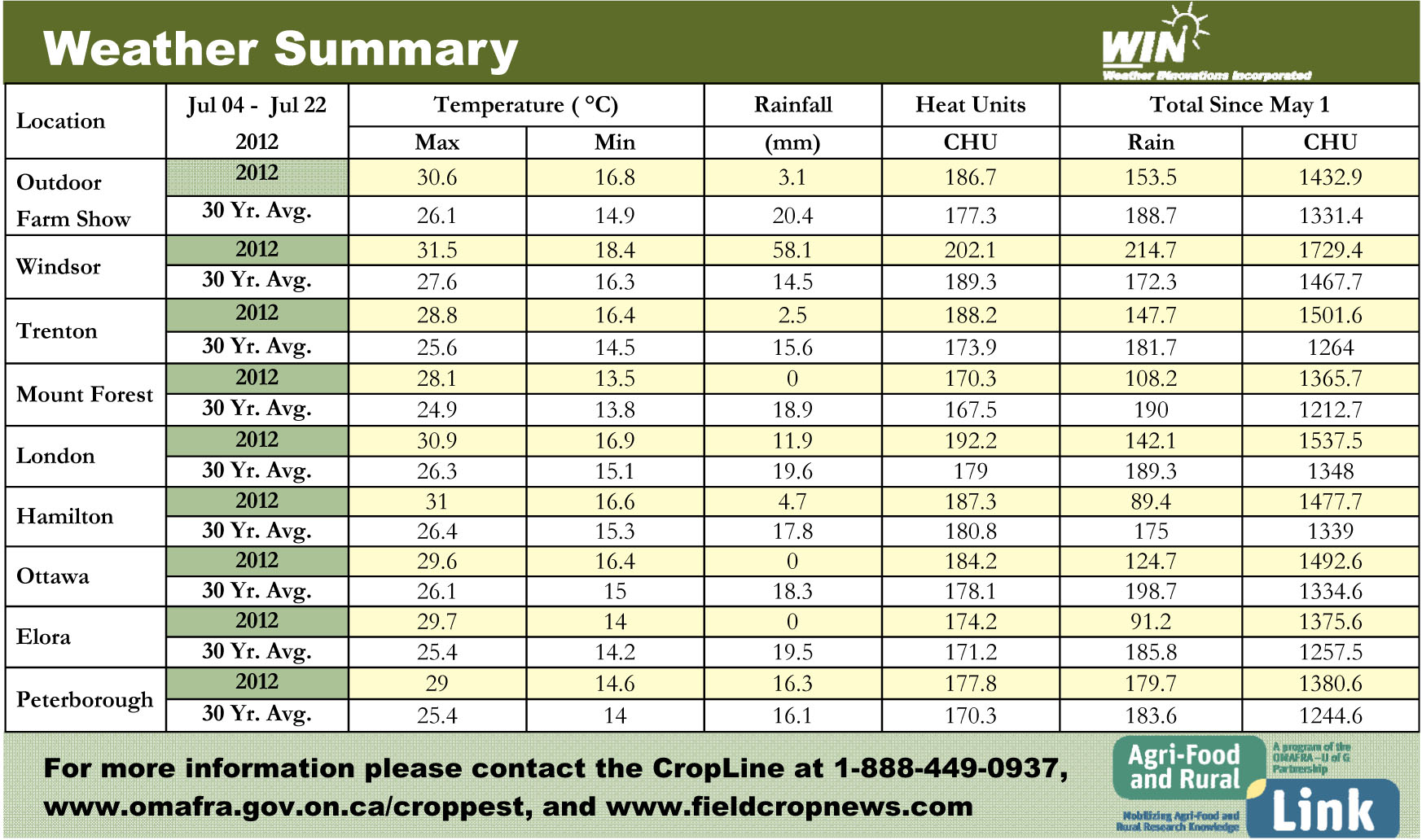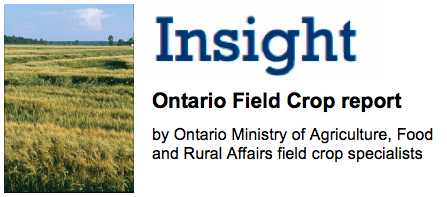Cereals: Peter Johnson/Scott Banks
Winter Cereals: Harvest is in high gear as far north as Mitchell, and starting in Bruce County. Yields are average, mostly 75 to 95 bu/ac. Poor fields are 60, with best fields at 110. Quality is excellent, with very low fusarium. Protein in hard reds is inconsistent. Sprouting in white wheat is an issue southwest of London (the rain zone). Most growers are harvesting at 15-16% moisture to avoid quality and yield loss. Straw is tough with late tillers causing green kernels and heads in the sample.
Premature death of some plants has caused areas to appear “black” in the field. This is alternaria or “sooty mould”, a secondary infection with no yield impact. Growers should investigate to determine the cause of the early death.
Spring cereals: continue their rapid pace of development, with high temperatures and dry conditions putting the lid on yield potential. Barley harvest is beginning.
Corn: Greg Stewart
Tassel emergence is now evident in a significant portion of the crop. Moisture stress is quite severe in some areas particularly on the sands and heavy clays. The majority of the crop on medium textured soils is showing leaf rolling during the day but recovers in the overnight period. Plants that recover can have good pollen shed and silk receptiveness in the morning hours even if the plant does tend to shut down later in the day.
Dry weather stress may contribute to poor synchronization between pollen availability and silk receptiveness resulting in poorer pollination. If dry weather continues even successfully pollinated kernels can abort in the period shortly after the pollination.
Fungicide applications are more likely to result in significant yield boosts when the following conditions are present: 1) large, high yield potential canopies; 2) corn follows corn in rotation; 3) leaf diseases are evident on the ear leaf and 4) rainfall at and following tassel emergence is above average.
Forages & Pastures: Jack Kyle / Joel Bagg
Pasture: Forage growth on pastures has slowed or stopped due to dry conditions. Monitor your pastures and plan for the next couple of months. What quantity of forage is required and how much is available? If you have a feed shortage and don’t have other feed options then animal numbers may
need to be reduced. The fact sheet Dealing with Feed Shortages on Your Beef Farm at http://bit.ly/NhuSnl can help you work through the process. Annuals, in particular oats, planted after wheat harvest can
provide an early fall feed source.
Forage: Potato leafhoppers (PLH) are being reported at damaging levels in many areas across the province, including areas where they are not typically a problem. PLH dramatically reduces alfalfa yield and forage quality. Reduced stem and root growth, and vigour results in stunting and slow regrowth. New seedings are very susceptible and can be permanently damaged, so be sure to check these fields. Adult PLH are 1/8th of an inch long, lime-green and wedge-shaped. They insert a stylet into a leaf midrib and inject a toxin that results in a wedge-shaped yellow “hopperburn”. Damage is often confused with moisture and heat stress. Once hopperburn is observed, the damage is done and it is too late for control, so scout and be prepared to spray (http://fieldcropnews.com/?p=3902 ).
Soybeans: Horst Bohner
Soybean growth has been slow in those areas that missed the rains. Fields are now at the R2 (full flower) growth stage. Those areas that received adequate moisture are progressing well and are entering R3 (beginning pod). Soybeans flower over an extended period of time so areas that have been negatively impacted from the lack of moisture can still “catch up”. Significant yield losses do not generally occur unless moisture stress continues into the R4 (full pod) growth stage. The majority of soybean yield is set during the last week of July and during the month of August. Growing conditions during that time have a larger impact on yield than growing conditions during the early growth stages of plant. At this time of year yellow patches of stunted plants can sometimes be seen in fields with disease or pest issues. Take the time to diagnose the issue so that the correct management strategy can be employed. Soybean cyst nematode (SCN) and Rhizoctonia is more evident than usual this year.
Crop Diseases: Albert Tenuta
Remember the primary SCN symptom is often no above ground symptoms at all. Growers are advised to scout for SCN by carefully digging-up plants, gently remove the soil and examine roots for the "pearl white to yellow" cysts. This goes for growers who are using SCN resistant varieties as well since SCN field populations can adapt to these varieties resulting in increased cyst reproduction and yield losses. Also look for Rhizoctonia root rot which forms reddish-brown lesions on the stem at, or just below, the soil line. These lesions are sunken and remain firm and dry unlike Pythium/
Phytophthora which results in a “wet rot”. In corn, environmental conditions have not been conducive to foliar leaf diseases across most of the province. Most foliar diseases require prolonged wet conditions on the leaves for leaf infection but only under favourable temperatures (16-30oC) and as a result the need for fungicide’s for disease control is low at this time. See CropPest Ontario newsletter Issue 5 “Fungicide Efficacy for Control of Corn Diseases” or http://fieldcropnews.com/2012/07/




